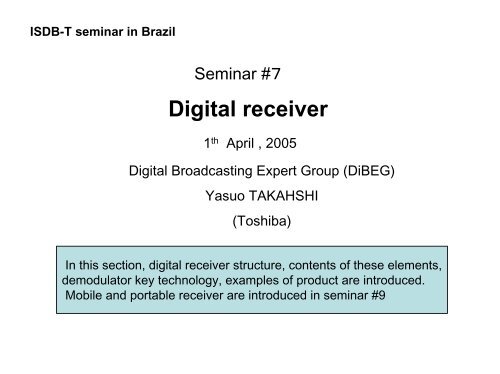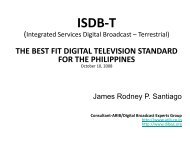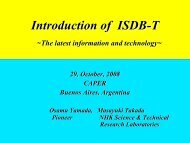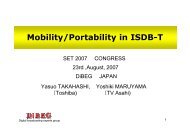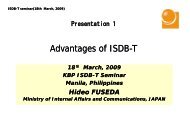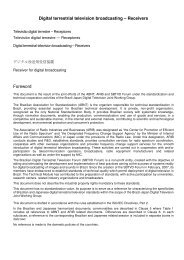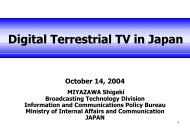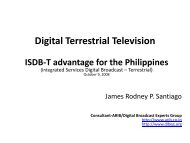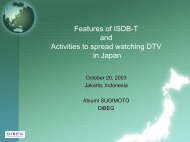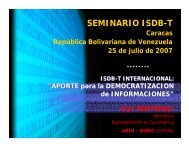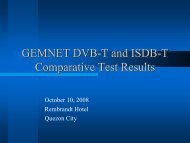Digital receiver - DiBEG
Digital receiver - DiBEG
Digital receiver - DiBEG
- No tags were found...
Create successful ePaper yourself
Turn your PDF publications into a flip-book with our unique Google optimized e-Paper software.
1. Configuration of digital <strong>receiver</strong>1.1 Basic configuration of digital <strong>receiver</strong>1.2 Specifications of tuner unit
1) Satellite receiving antenna2) 4)IF inputcoupling cableConverter3) DIRDDecoder,descramblers,etc.Video outputAudio outputHDTV-SDTVVideo andaudio monitor5)Terrestrialreceivingantenna6) Coupling cable betweenthe terrestrial receivingantenna and DIRDCA moduleHigh-speeddigital I/OSeparate-typedata decoder,DVCR, personalcomputer, etc.Telecommunication-line connection<strong>Digital</strong>-broadcasting <strong>receiver</strong>Basic configuration of the <strong>receiver</strong> (see B21, Fig. 2-1)
Satellite front endTuner packTuningOrthogonal detectionDemodulation/decoding(8PSK, etc.)De-interleavingFrame separationDescramblerInteroperabilityconnection unitTSs of Terrestrial adapter, CS and CATVReed-SolomondecodingTSTMCC decodingTerrestrial front endTuner packTuningDetectionDemodulation/decoding(64QAM, etc.)De-interleavinghierarchicalprocessing, energyinverse-dispersal,etc.TS regenerationTSTMCC decodingCA descramblerMPEG-2DEMUXEPG, primarydata decoderCA moduleVideodecodingHD video outputMODEMAudiodecodingHD-SD D/CSD video outputAudio outputHigh-speed digital I/OBasic configuration of DIRD (see B21, Fig. 2-2)
2. Specifications of tuning unit (quoted from ARIB STD-B21)(1) InputImpedance: 75 ΩReceived frequency: UHF ch 13-62Center frequency:473 + 1/7 MHz (ch 13), 479 + 1/7 MHz (ch 14), . . .,and 767 + 1/7 MHz (ch 62)(2) First intermediate frequencyCenter frequency:57 MHz (frequency reversed)Local oscillator frequency: At the upper side of the received frequency(3) Synchronization range of the received frequencySynchronization range of the received frequency: ±30 KHz or wider(4) Synchronization range of the received clockSynchronization range of the received clock: ±20 ppm or wider(5) tuning unitMinimum input level: -75 dBm or lower (targeted value) (SeeAppendix 10.).Maximum input level: -20 dBm or higher.
Protection Ratios of the 13-segment <strong>receiver</strong> (see B21,Table 5-2 )Undesired waveAnalog television<strong>Digital</strong> televisionItemFrom the co-channelFrom the lower adjacent channel(undesired wave on the lower side)From the upper adjacent channel(undesired wave on the upper side)From the co-channelFrom the lower adjacent channel(undesired wave on the lower side)From the upper adjacent channel(undesired wave on the upper side)Protection Ratio18 dB or less-33 dB or less-35 dB or less24 dB or less-26 dB or less-29 dB or less(Note) The transmission parameters used for the measurement must be asfollows: Mode 3, guard interval ratio of 1/8, no time interleaving, modulation of 64QAM, and an inner-code of 7/8 (See the Appendix.)
Outline of digital <strong>receiver</strong>(tuner and demodulator section)Antenna~57-MHzIF circuit~A/CFFTCarrier demodulationdifferentialdemodulation,SP demodulationFrequencydeinterleavingTimedeinterleavingOrthogonaldemodulationSynchronizationregenerationDemappingQPSK16QAM64QAMFrameextractionTMCCdecodingDivision intohierarchical levelsBit deinterleavingBit deinterleavingBit deinterleavingDe-puncturingDe-puncturingDe-puncturingCombining ofhierarchical levelsViterbidecodingDivision intohierarchical levelsByte deinterleavingByte deinterleavingByte deinterleavingEnergyinversedispersalEnergyinversedispersalEnergyinversedispersalTS regenerationRSdecoding
2.2 Key Technology for RX Synchronization*4-element synchronization is required(1) Carrier Synchronization: AFC(2) Clock Synchronization(3) FFT window timing(4) Frame SynchronizationFor Item (1) through (3), new synchronization methods areproposed
Key Technology-RX SynchronizationNew Technology Auto and Cross Correlationfor guard intervalcopycopyguard intervalsame waveformsymbolsame waveformThe waveform of guard interval is same as the one atend of symbol. Thus Auto-correlation between the guardinterval and the end of symbol is high.
Key Technology: RX SynchronizationTgTsTs delayAuto-correlationfunctionTimeStrong Correlation within this period
Key Technology-RX SynchronizationDetect the Window TimingD/CFFTAuto-correlationSquare RootSumTs delayAverageTsAuto-correlation Waveform
Key Technologies-RX SynchronizationAFC: frequency offset error detectionD/CIQFFTCross correlationTs delayTs delayaverageaverageSiitan-1(Siq/ Sii)SiqFrequency offset error
Key Technology-RX SynchronizationAFC: frequency offset error detectionSii:cross correlation between I and delayed ISiq:cross correlation between I and delayed Qtan-1(Siq/Sii)0-1.0 0.0 1.0 2.0Normalized Frequency Offset
Key Technology-RX SynchronizationComposition of OFDM FramefrequencytimeScattered Pilot SignalTMCC carrierContinual Pilot signal
Key Technology-RX SynchronizationComposition of OFDM FrameSP: scattered pilot signal; used for equalizing of informationsignalAC&CP; used for the frequency offset detection and carrierreferenceTMCC(note): Transmission and multiplex configuration control:used for the transmission status information and framesynchronization(note)In DVB-T, called TPS (Transmission parameter signal)
Key Technologies-RX SynchronizationDetection of Frame TimingFFTSelectTMCCCarrierDetectFrame SyncWordFrame SyncTimingNote: The Frame Sync Words are located on the top ofTMCC carrier
Key Technologies-Error ControlBlockdiagram of FEC EncoderReed-SolmonEncodingEnergyDispersalByteinterleaveViterbiEncodingBitInterleave(Outer Code)(Inner Code)CarrierModulationTimeInterleaveFrequencyInterleaveOFDMFramingTo IFFT
3. <strong>Digital</strong> <strong>receiver</strong> system3-1 Function of digital <strong>receiver</strong>3-2 Configuration of digital <strong>receiver</strong>3-3 Outside view of digital <strong>receiver</strong>
3-1 Basic function of digital <strong>receiver</strong>mediaReceptionstyleTransmissionsystemdecodingBS-digitalfixed8 PSKMPEG2-videoAAC-audioBML-dataCS-digitalfixedQPSKSame as aboveTerrestrialdigitalFixed (note)handheldOFDMOFDM(1segment)Same as aboveH.264-videoAAC-audioSimple BML-data(note) mobile reception service is possible in fixed reception service
3-1 function of digital terrestrial TV <strong>receiver</strong>(1) Receiving antenna;UHF 13-62 Ch (470-770MHz), 14 element Yagiantenna(7dB/UHF13Ch) or more performance is desirable(2) Receiver tuner; minimum input level is as low as -75dBmRequired D/U against interferenceantenna57MHzinterferenceAnalog TVitemCo-channelratio18dB>mixer IF mixerLower-adjacent-33dB>Upper-adjacent-35dB>LocalOSC.LocalOSC.<strong>Digital</strong> TVCo-channelLower-adjacentUpper-adjacent24dB>-26dB>-29dB>
3-1 function of digital terrestrial TV <strong>receiver</strong>(3) Signal processing at front end portion;A/D, Quad. Demodulation, frequency/time de-interleave,64QAM, Viterbi decoding, hierarchy division, deinterleave,TS recover, RS decoding(4) TS(Transport stream) processing;Recover the section data and PES data from TS(5) Audio signal processing;Decode AAC LC profile of MPEG-2. Decoding systemsare mono, stereo and multi-channel(3/1, 3/2, 5/1 CH)
3-1 function of digital terrestrial TV <strong>receiver</strong>(6) Video decoding processing;Decode HL, H14, ML, LL of MPEG-2 main profile. Theoutput format is either of 1125i, 750p, 525p, 525i format.source 4:3 monitor 16:9 monitor16:9Letter boxSame as left16:9 sidepanel4:3Letter boxDelete sidepanelSame asleftLetter boxAdd sidepanelAdd side panelor extendhorizontal axisExpand upperand lower
3-1 function of digital terrestrial TV <strong>receiver</strong>(6) Video signal processing;D type output terminalD terminalspec.480i 480p 1080i 720p 1080pD1xD2 x xD3 x x xD4 x x x xD5 x x x x xY, Pr, Pb + control signal
3-1 function of digital terrestrial TV <strong>receiver</strong>(7) Display of data broadcasting (graphic display)display pixell; 960 *540 (half of 1920* 1080)Motion picture planeselect1- αα; blending factorStill picture planeText /object planeCLUTα+CLUT; color look up table
3-1 function of digital terrestrial TV <strong>receiver</strong>(8) Function of bi-directional communication-communication by Ether-net (TCP/IP)(9) <strong>Digital</strong> interface- IEEE1394 (DVHS, etc)
Example of digital <strong>receiver</strong> block diagramBS tuner8 PSKDEM.System LSI256MbitDDR memoryVTR outputTerrestrialtunerTerrestrialanalog tunerOFDMDEM.De-MUXMPEGDEC.FormatConv.GraphicprocessNTSCDEC.MPUPDP/LCDbackend proc.CRTbackend proc.DAC,コーデックdisplayaudioOpticaldigital audioADCGhostreductionNTSCDEC.IEEE1394 LAN modem Card I/FCAS I/FDVD/VTRiLINK Ether TEL MemorycardBCAScard
3-2 composition of digital <strong>receiver</strong>(1) Tuner block; 2 type of tuners, analog and digital(2) Analog signal proc. block; Analog tuner input and external NTSCinput is decoded and output as digital signal.(3) System LSI; divide digital broadcasting stream processing, decodeMPEG-2 video/audio decoding, format conversion, graphic processing,capture of NTSC, NTSC encoding, system control and databroadcasting processing by 32 bit on-chip RSIC processor(4) input/output; IEEE 1394 terminal to DVHS, LAN connector,MODEM connector, slot of multi-memory card, optical output fordigital audio.(5) Back end processor; separate CRT and LCD/PDP signal processingcircuits
3-3 digital TV LSI boardBS tunerMPEG decoder LSIBack end proc.for flat panel8 PSKOFDMTerrestrial TV tuner
3-3 Hi-vision TV for digital terrestrialTV broadcasting32D400026L400, 32L4000, 37L4000 42P4000
Price of Wide screen digital TVIn Japan, all type of wide screen digital TV sets have HDTV performance.For this reason, it seems to be slightly expensive, but in a couple of years,the price of digital TV with wide screen for HDTV become cheap rapidly.The target price is as much as 100 $/1 inch.(note) in Japan, more than 50 % of program of digital TV should be HDTV,therefore, all types of wide screen digital <strong>receiver</strong> is compatible to HDTVdisplay.
4. Software of digital <strong>receiver</strong>4-1 composition of software in digital<strong>receiver</strong>4-2 version up of soft ware4-3 function of communication of digital<strong>receiver</strong>
4-1 Software stack of digital <strong>receiver</strong>applicationBML browser user I/F tele-text/ character inputUppermiddle-wareCH.Select data EPG schedule mode mange video manageLowermiddle-wareOSCA TS manage MPEG comunication iLINK fileLinuxGraphiclibraryDevicedriverTS MPEG Ether VBI data 1394 memory card graphics
4-1 Structure of BML browserInternaldatamemoryBrowser core blockdisplaymanageDOMCSSeventprocessparserMonomediaDec.displaymanageECMAscriptContentsmemoryvideo/ audioGraphic libraryMemoryfor workextendAPI
4-2 software version upmethod of down load(1)broadcast wave (auto)(2)broadcast wave (any)(3) memory cardcontents of soft wareimproved softwareadd functionindividual user(1)mainly correct bug of software (mainly used) *(2)up version of function (HTML)(3) up version of function (TV set)*version up automatically at stand by mode
4-2 software download(1) Information is broadcasted through all channels such asservice ID, schedule, <strong>receiver</strong> type which should bedownloaded, etc.(2) Receiver gets the download data during stand by mode.The download data is different for maker ID, type No., groupNo., and version No.(3) Download data is transmitted through the engineering Ch ofBS-3 for satellite media, and NHK general Ch and NHKeducational Ch for terrestrial media.
4-3 communication function of digital <strong>receiver</strong>• Data broadcast: The contents on the web servers related withthe broadcast program can be displayed through TCP/IPcommunication. Text data is also transmitted by IP packet.• Download function: Software can be downloaded not onlythrough the broadcast channel but also through the internet.• Home networking: <strong>Digital</strong> TV <strong>receiver</strong> can be connected withthe DVD recorder by TCP/IP communication.• Web browsing: By installing HTML browser into the digitalTV, the internet Web browsing will be possible.
5. LSI for digital <strong>receiver</strong>5-1 LSI system of digital <strong>receiver</strong>5-2 OFDM demodulator LSI5-3 MPEG decoder system LSI5-4 back end video processing LSI
Example of digital <strong>receiver</strong> block diagramBS tunerTerrestrialtunerTerrestrialanalog tuner8 PSKDEM.OFDMDEM.256MbitDDR memoryMPEG system LSIMPEG decodeFormat converterGraphic proc.MPU256MbitDDR memoryPDP/LCDbackend proc.videoaudioADCGhostreductionNTSCDEC.IEEE1394 LAN Card I/FiLINK Ether Memorycard
5-2 OFDM demodulatorLSI (TC90A87FG)IF input57MHzADCEQQuad. Dem.FFTAFCRS Dec.TSoutput1 MbmemoryinterleaveViterbi Dec.
5-2 Feature of OFDM Dem. LSI- Compatible to all parameters defined in ARIB spec.- Compatible to 13 segment, 3 segment and 1 segmenttransmission.- Use wideband ADC. Possible to input 57 MHz IF signaldirectly.- Equip the interference reduction circuit against analog TVsignal interference.- Equip the memory ,decision circuit in LSI. Only crystal isrequired as a outside part.- 2 type of package, 114 pins QFP and 13 mm square BGA.
5-3 MPEG decoder system LSI(TC81240TBG)64 bit DDR-SDRAMTS inputTS outputTSProc.SDRAM cont.MPEG videodecodeVideo formatproc.Graphicproc.videoPCIPCICont. proc.Audio Dec.audioUSBUSBTX49 core(64 bit RSIC)NTSC Enc.analogvideo
5-3 Feature of MPEG decoder LSI- Host MPU; 64 bit RISC (TX49 core), 230 MIPS processor- TS processing; 3 input, 48 section filter/TS- De-scrambler; MULTI-2, DMULTI2, DES/TDES , DVB- Audio; AAC, AC3, MPEG1,2- MPEG video decode; 2 CH HDTV decode- Display plane; video 2, graphics 2, carsol/background 1- Graphics; bitBLT, scaling, alpha blending- Progressive scan conversion; motion adaptation, intra field, intra frame.- Noise reduction; motion adaptation, frame recursive type- Video encoder; NTSC/PSL/SECAM- Number of gate; 2.7 M gate, BGA 648 pin
5-3 back end video processing LSI(TC90A94TBG)DDRーSDRAMSDRAM cont.HostMPUVideoinputMotion vector det.Vertical scalerMatrixHor. compress4:2:2-4:4:4Hor. scalerLum. proc.Chroma proc.RGB conv.OSDalpha blendvideo outvideo
5-4 Feature of Back End Video Processing LSI• Input signal: TV signal(480i/p,720p,1080i) and PC signal(VGA,SVGA,XGA,UXGA PC)• Output signal: Panel size of 853x480, 1024x768, 1280x768,1366x768, 1920x1080• Format conversion: Motion compensated i/p conversion (480i)and motion adaptive conversion (1080i)• Scaling: Horizontal/Vertical 1/3-3 nonlinear• Picture quality control: Horizontal/vertical enhancer, Blackenhancer, gamma correction• Noise reduction: Motion adaptive frame recursive type• OSD: 128 colors, 256 alpha blending• Number of transistor: 12.6M Transistor, Package: BGA480pin
6. Recording and RMP (note) in digital broadcasting(note) Right Management and Protection6-1 digital recorder for broadcasting6-2 recording time of digital broadcasting6-3 specifications of IEEE13946-4 copy control for digital broadcasting contents (RMP)
6-1 Recorder for digital broadcasting(1)digital VHS:digital record on VHS tape(via IEEE1394(iLINK))(2)hard disk recorder(with tuner, via iLINK)(3)next generation( blue laser) DVD23GB recording on DVD disk
6-2 recording time of recorderMediaFor recordingcapacityRecording timeBS(22Mbps) Terrestrial(15Mbps)D-VHS60GB6 hours8.8hoursHard disk200GB20 hours15.5 hoursDVD (red)*4.7GB28 minutes41 minutesDVD (blue)23GB2.3 hours3.4 hours*in case of DVD (red), record after down conversion to 525i
6-3 IEEE1394 interface(1) iso- chronus transmissionperiod T(2) Copy control by TCP system-equipment authorization-Key exchange-transmit encryption data(M6)-copy is controlled by CCI00 Copy free10 Copy once01 No more copy11 Never copy
6-4 RMP application for digital broadcasting(1) BS and terrestrial broadcasting;even though free program, scrambled by BCAS. Applycopy once mode. Started April 2004.(2) BCAS card;provide to user within same carry box. The card does notprovided to unauthorized equipment.(3) Authorization for new type equipment;according to application, check and give authorizationAuthorized; DTCP,CPRM, BlurayFor memory card, DTCP over IP, wireless LAN, futurediscussion
Copy control for DVDformatCPRMDVD-RAMDVD-RWDVD-RVideo formatinvalid-OKOKVideorecording(VR) formatvalidOKOK-CPRM; Copy Protection for Recordable Media
6-4 charge system by scramble for BSBCAS(Conditional Access System)videotransmitterScrambler(MULTI2 system)Broadcastwave(scrambled)BS <strong>receiver</strong>Descrambler(MULTI2 decode)Scramble keyChange every1 secondWork keyScramble keyWork keyUser keyChange every1 monthSecret personal keyCPUmemoryIC cardScramble keyWork keyUser key
6-4 Composition of RMP in <strong>receiver</strong><strong>Digital</strong> <strong>receiver</strong>TV monitortunerMPEG decodeAnalog out(macro-vision)Even thoughfree program,scrambledHDD recordingis locallyencrypted bycommon key of56 bit or moreDe-scramblelocalEncrypt/decryptHDDDVI1394DVD RAMNetwork<strong>Digital</strong> out(HDCP rule)DVHS recorderIEEE1394(DTCP rule)DVDRAMDVD record(CPRM, Bluray)Internet, LANWireless is future questionCard id not provided to unauthorized <strong>receiver</strong> (enforcement)
7. New type display7-1 Liquid crystal display7-2 plasma display TV (PDP)7-3 FED(Field Emission Device)7-4 Feature of each display7-5 Projection TVIn this section, wide screen and high definition flat displays areintroduced, this device is indispensable for HDTV.
7. New type displayPlasma display TVLiquid crystal display TV
7-1 Liquid crystal displayColor filterglasselectrodeLiquid crystalvoltageelectrodeglassPolarization board300 thousand pixelBack light (white light)
7-2 plasma display TV (PDP)lightplasmaSDTV; 300,000HDTV: 1,000,000electrodeFluorescentsubstanceDrive pulseOFFONelectrode
7-3 FED(Field Emission Device)electrode(+)Fluorescentsubstanceelectrode(-)boardsame principle of cathode ray tube
7-4 feature of each displayitemLCDPDPFEDremarksAverageblightness121To save powerconsumption, PDP is notso goodPowerconsumption231Motionpictureperformance321contrastDarkposition ; 1Blightposition; 421Visual angle311Self lightning system isbetter1; best, 2; better, 3; good , 4; not so good
7-5 Projection TV40-60 inchscreenmirrorLCD panelProjection TV40 cmLight source
8.examples of productsIn this section, mainly introduce the fixed reception typedigital <strong>receiver</strong>. Mobile and handheld <strong>receiver</strong> will beintroduced in seminar #9)
Rapid increase of DTTB Receiver ShipmentNumber of DTTB Receivers (thousand)25002000150010005003260Total Sum untilNov,2003■ Per Month■ Total169495Dec55055 71Jan,2004621DTTB Start11673782083 989181063Feb Mar Apr May Jun144 15512181341123 1331474Jul Aug Sep15816322021834Oct Nov3272161Dec2.4 million <strong>receiver</strong>s are in the market1092270Jan,2005
<strong>Digital</strong> TV ProductsPlasmaPDPPanasonic
LCD<strong>Digital</strong> TV Products
<strong>Digital</strong> TV ProductsCRTSTB typeMore manufactures are entering the market!
All-in one DTTB Receiver94% of DTTB <strong>receiver</strong>s are all-in-one DTTB <strong>receiver</strong>s‣ Equipped with digital terrestrial and satellite tuner‣ Compatible with HDTV (1080i)‣ Equipped with data broadcasting decoder‣ Capability to connect networkMany models have internet web browsing functionIn addition, more than 3 million of HDTV ready TVs(HDTV display without DTTB tuner) have alreadyshipped.
Example of Internet TVPortal SiteCharacter InputButtonInternet ButtonOperationButtonAccess toFavorite Site
Example of Internet FunctionInternet ScreenOne Screen ModeInternet ScreenTV ModeTwo (TV + Internet) Screen Mod
Example of Internet TVEPG and T-navi Portal SiteT-navi: dedicated sitesfor TV internet viewers
Example of Internet TVT-navi Menu ListNEWSTravelShopping
Example of <strong>Digital</strong> TV Product1920x1080 full HDTV resolution LCD display<strong>Digital</strong> HDTV recorder (HDD+DVD) with digital TV tuner
Example of <strong>Digital</strong> TV PC ProductEPG enables to record TVprogram to PCPC with DTTB tunercard
Example of Product(CATV <strong>Digital</strong> STB)DTTB is broadcastedvia CATV with 64QAMtransmodulation.1.0 million CATV digitalSTB are in the market(Dec.2004)
END of seminar #7


